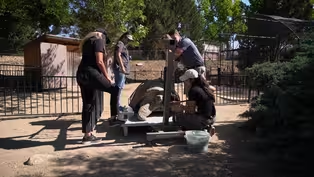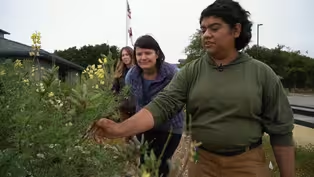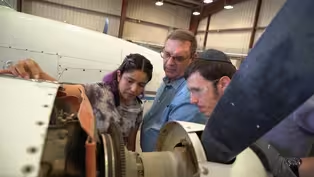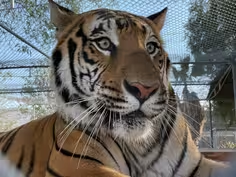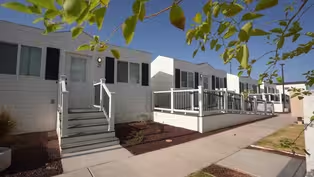Inside California Education
Community Colleges – Teaching Zoo
Season 4 Episode 7 | 26m 46sVideo has Closed Captions
Step inside a unique zoo in Southern California run by community college students.
Visit a zoo in Southern California where students learn how to care for exotic animals. Discover how a community college in Imperial Valley built tiny homes for their students facing homelessness. Meet students who are participating in prestigious science internships near Monterey. See what careers are taking off from this aeronautical and aviation technology program.
Problems playing video? | Closed Captioning Feedback
Problems playing video? | Closed Captioning Feedback
Inside California Education is a local public television program presented by KVIE
Funding for the Inside California Education series is made possible by the California Lottery, SchoolsFirst Federal Credit Union, Stuart Foundation, ScholarShare 529, and Foundation for the Los Angeles Community Colleges.
Inside California Education
Community Colleges – Teaching Zoo
Season 4 Episode 7 | 26m 46sVideo has Closed Captions
Visit a zoo in Southern California where students learn how to care for exotic animals. Discover how a community college in Imperial Valley built tiny homes for their students facing homelessness. Meet students who are participating in prestigious science internships near Monterey. See what careers are taking off from this aeronautical and aviation technology program.
Problems playing video? | Closed Captioning Feedback
How to Watch Inside California Education
Inside California Education is available to stream on pbs.org and the free PBS App, available on iPhone, Apple TV, Android TV, Android smartphones, Amazon Fire TV, Amazon Fire Tablet, Roku, Samsung Smart TV, and Vizio.
Providing Support for PBS.org
Learn Moreabout PBS online sponsorshipChristina: Coming up on Ana: Say hi Peaches!
Hi Peaches!
Visit a zoo in Southern California, where community college students come from all over the world to learn how to care for these exotic animals.
Ana: That has always been my goal, to be on the other side of the fence.
Christina: Discover how a community college in Imperial Valley is helping students who are facing homelessness... by building a community of tiny homes.
Martha: So in that small space, they have everything that they need, and it'’s a safe living community.
Christina: Plus...meet students who are participating in prestigious science and STEM internships through their community college near Monterey.
And see what careers are taking off from this aeronautical and aviation technology program, in a valley that'’s home to some of the largest aerospace companies in the world.
Ty: Today, what we'’re actually going to do is remove an aircraft starter.
Christina: It'’s all next, on Inside California Education: Community Colleges Annc: Inside California Education: Community Colleges is made possible by: College Futures Foundation believes nothing is more transformative for individuals in our society than an educational opportunity.
We partner with organizations and leaders across California to help students earn college degrees, regardless of zip code, skin color or income.
More information at collegefutures.org.
♪♪ ♪♪ Mara: America's Teaching Zoo is a zoo.
It'’s a real zoo!
Rob: It'’s called America'’s Teaching Zoo because it'’s located right on the campus of Moorpark Community College in Ventura County.
Mara: All the things you would find at a regular zoo are found right inside those gates.
We house 120 different animals representing about a hundred different species.
We have birds, mammals, reptiles, primates, you know tigers, hyenas.
Rob: Just as surprising as the wide variety of animals at this zoo... is who'’s taking care of them.
More than 40 students from Moorpark College are in a program that teaches them how to handle and care for these zoo animals.
Mara: Our students are really getting a briefing on what the lifestyle is as a zookeeper and an animal care professional where the creatures are the teachers.
(Tiger sounding off) Mara: The exotic animal training and management program is a major here.
It's a tried and true curriculum with very qualified instructors and staff and a program that's been around since 1974.
It is so unique and so one-of-a-kind.
Students come here from all over the country, even all over the world "raise hands" Rob: Students like Charlie Burke... She came all the way from Ireland to be a part of the program.
"Give me hands" Charlie:It's an amazing opportunity to be here.
Every single day, it's so amazing to work with these animals.
There is a lot of nitty gritty and down and dirty, and you never know what's going to come at you.
You never know if you're going to get peed on by a tiger or have to pick up tiger poop, you know, but that's part of it and that's what's super fun.
Rob: On this early morning, Charlie and her team of classmates are starting the day working in the zoo'’s carnivore section.
"Order a lockdown" Charlie: So first thing in the morning we start and get all the animals on the entire facility cleaned and kind of getting them ready for the day.
Charlie: Everybody wants to be here and everybody wants to learn from the animals and they want to learn from each other.
And it's such a unique experience.
Rob: The Exotic Animal Training and Management Major Program offers both classroom experience as well as hands-on training.
Mara: This is a very condensed amount of time in which we test them to really determine if this is something they want to do for the rest of their lives.
It's not for everyone waking up early, and running to roll call and being in the heat or in the rain and working long hours and sometimes spending the night here.
It'’s not exactly what some people have in mind when they imagine their big zoo career.
And it can be disenchanting sometimes for people, but what this field is, is a lifestyle.
Charlie: It's challenging in a lot of unexpected ways.
It pushes you out of your comfort zone every single day.
Rob: For some students, the biggest challenge is not working with animals... it'’s working with people.
The zoo opens to the public on most weekends, and that'’s when students are expected to practice their speaking skills while educating visitors.
Mara: That is the time when our students really get to put what they're learning in the classroom during the week to practice.
Teacher: Alright everybody, let'’s head out to our areas!
Charlie: We'’re up on stage talking to a whole audience.
You have microphones.
Now you're also talking about animals.
Then you're also working with an animal on stage and that puts so many different elements into it.
Juluis: That's what the zoo does.
Right?
It builds and fosters an awareness.
A passion for animal husbandry.
And it builds a passion for conservation.
Julius: The zoo itself started as a labor of love.
It was an opportunity to rehab and extend the experience and the life of animals who had been in the industry and it'’s one of the most successful programs on our campus because we get employment and placement for students even before they complete the program.
At the end of the day, Moorpark college is really about supporting the individuals who live in our community to do whatever they want to, whatever their dreams are, right?
Ana: Say hi Peaches!
Hi Peaches!
Rob: Ana Hugues is in her second year of the program, and hopes to get into animal conservation after she graduates.
Ana: I would love to work with rhinos specifically.
That's my favorite animal so I would love to work in a rehabilitation center, so maybe a rhino orphanage, do conservation work.
Try to make a difference.
Ever since I was a little kid, that has always been my goal to be at the other side of the fence.
You know, not being a guest, being the person actually working with the animal and trying to be able to help the species.
(Crunch) Rob: Ana and her classmates are giving Clarence, a Galapagos Tortoise, a routine clean up on the bottom part of his shell.
Ana: He has no way of cleaning that part himself so he needs vet staff, or us, to actually clean that for him.
Ana: What I find the most rewarding is the relationship that you build with the animals.
So you get a bond with that animal, the animal trusts you.
We're all here for the animals.
For their welfare.
Charlie: It's really neat to see how do we work together.
How can we all come together and appreciate being on this animal?
And how do we do what'’s best for that animal?
Mara: It's the students that inspire me because I see them just show up day after day and they're ready to help animals and change the lives of animals in a zoo setting.
♪♪ Kristen: Cierra Gibbs is enjoying the comfort of studying in her home.
And it'’s something she doesn'’t take for granted.
Cierra Gibbs: It's tiny, but it'’s literally all you need it's perfect.
I like being able to come home from work and not have to worry about like looking around and feeling like, you know, unsafe.
And so it's nice to not to have to do that anymore.
Kristen: It's a far cry from where Cierra came from... Cierra: It's been almost a year since I haven't had to wonder where I'm going to be for the night.
I was homeless.
Staying here and there.
Probably places I shouldn't be staying.
Kristen: She now lives in the Lotus Living Community.
a housing community for Imperial Valley College students who were homeless or face homelessness.
It'’s one of the only California community colleges to provide such housing for their students.
Dr. Martha Garcia: Knowing that our students were living in these conditions that they were, living in their cars when it's 120 degrees outside.
I couldn't be at peace with myself if I didn't do something about it.
Kristen: Dr. Martha Garcia is the former president of Imperial Valley College who made it her mission to address the student homelessness problem.
Martha: What resulted was a tireless commitment to create a community of purpose, a community of care, a community of hope.
Kristen: At the Lotus Living Community, there are 26 units and each unit measures only 170 square feet.
They call them, "“tiny homes.
"” The student-residents are expected to pay a flat two hundred dollar monthly fee to cover utility costs.
Martha: Those tiny homes have a bed, they have a desk, they have their kitchenette, that they have a washer and dryer.
They have their own restroom.
So in that small space, they have everything that they need, and it's a safe living community.
Kristen: Imperial Valley College in California'’s Imperial County is close to the borders with Arizona and Mexico.
It'’s a rural community with many challenges, including high rates of poverty, unemployment, and homelessness.
Imperial Valley College itself has over 200 students who identify as being homeless or at risk of being homeless.
Martha: Our community is aspiring to obviously do better.
And as the only community college serving this county, obviously education plays a major role.
Lennor Johnson: We're here to help.
We're here to serve.
We're here to make a difference in, in our community's lives.
Kristen: Dr. Lennor Johnson is the current president of Imperial Valley College who worked closely with Dr. Garcia on the housing project.
Lennor: It'’s really is a powerful, powerful thing that I think we're doing and it really took a village to make this happen.
Martha: It really started from a dream, a dream of making this happen.
So I started knocking on doors.
I met with the CEO for the county of Imperial.
I met with the city manager for the city of El Centro Lennor: She started doing everything she can to fundraise.
She worked with the foundation she worked with State and Local officials and all of a sudden this Home Key grant came about and we got the funding Kristen: The college received over 3 million dollars in funding for the project.
After several years, Dr. Garcia'’s dream finally became a reality.
The Lotus Living Community was completed in the summer of 2021.
Martha: That community represents changing lives Lennor: It gives the students confidence that now I know I can do it and I have support that's going to help me do it Cierra: That's all I needed was... stability to get my mind right.
Like wow, okay, I don't want to just sit here, you know, and do nothing my whole life.
So I re-enrolled in school and that just started the ball on every blessing I've gotten after that.
Kristen: After receiving housing, Cierra got a job and now she has a car.
As for her education, she plans to major in behavioral science Lennor Johnson: I tell you, when you can help a student reach their goals...
I get a high from it when you see that transformation.
Cierra: Now I'm thinking back, like why, what didn'’t you do this a long time ago?
I know a lot of people don't like to ask, but it's so worth it to ask.
And that was my thing - I didn't want to ask for the longest time.
I just didn't want to face it.
And that'’s what I want everyone to know, they can change around if they want to...they just need that opportunity, like I needed.
Martha: That's why we're here - to support them so that ultimately they have an opportunity to live a better life ♪♪ Christina: Still ahead on Inside California Education: Community Colleges... Students get hands-on training at this hangar at a working airfield in Antelope Valley ... preparing them for careers in the aerospace industry.
But first ... see how these full-time, paid summer internships are setting students up for success in science and STEM fields.
♪♪ Christina: It'’s a foggy day on the Monterey Peninsula.
But that'’s a good thing, because it means it won'’t get too hot during this day of manual labor.
Citlally: Being five foot one, you don't think I'm gonna learn how to use a pickax one day and actually go out and do this really hard work.
They really push me to do work that I probably didn't think I could do.
Christina: Citlally Lopez-De Leon is a community college student at Hartnell College in Salinas.
She'’s also a paid summer intern at the Elkhorn Slough, working 40 hours a week, at this ecological reserve.
It'’s part of Hartnell College'’s internship program for students in STEM, or science, technology, engineering and math.
The community college has one of the largest STEM internship programs in the United States... placing students like Citlally at prestigious institutions to get the kind of hands-on experience that you can'’t get in the classroom.
Ariel: A lot of community college students they often don't have access to, uh, internships or, stipend projects outside of their immediate campus.
Uh, and I know from my experience as a college student, those internships are what build your career pathway.
Citlally: Today we will be collecting seeds from our sensory garden... Christina: Citlally splits her time between restoration work and educational outreach...giving tours like this one to the public.
She says she didn'’t expect to be able to do an internship while at a community college.
Citlally: So to see the opportunity pop up, it was like, '‘Oh OK!
'’ I really want to take that opportunity and get hands-on experience of what it's actually like to work in conservation.
Dr. Mohammed Yahdi: It allows them to discover skills they didn't knew they have and learn more skills that are not necessarily something they get into the classroom, but they are so useful for career in, um, in the workforce.
Christina: Dr. Mohammed Yahdi is the Dean of STEM at Hartnell College.
He says of the students who complete STEM internships, 91 percent transfer to a four year university an exceedingly high number.
Many of those community college students are from Salinas, and like Citlally, are the children of immigrants and farm workers.
Ariel: These are the kids who grew up roaming these trails, or at least roaming the local habitats, the local areas.
Um, they are so ingrained in this community and reflect, um, the diverse community that we have here.
Christina: Hartnell College typically places about 80 students in STEM internships each year at places like the Elkhorn Slough, local companies, or at universities doing graduate-level work.
The Naval Postgraduate School in Monterey has long accepted Hartnell community college interns.
These interns work right alongside interns from places like UC Berkeley and MIT.
Alison: They work hands-on with a faculty mentor and often with a team that may comprise of, uh, lab personnel and or military students that are here at the Navy school to get a higher education.
Christina: Jesus Delgadillo is a Hartnell student interning at the Naval Postgraduate School this summer.
He'’s working with assistant professor Andy Nieto on a 3D printer - exploring new composite materials that could potentially be used by the Navy.
Jesus: Two weeks into the internship.
I was like, wow, this is, this is very, it's very cool stuff.
I want to, I want to try something else with materials and maybe go in, uh, into the material science track.
Andy: Coming here allows them to get, you know, graduate level experience to encourage them to go to graduate school.
But also have experience of graduate school.
Christina: Jesus is a native of Salinas who earned his GED before enrolling at Hartnell College.
He says his plan is to transfer to CSU Fresno... and maybe even earn a master'’s degree after that, inspired by his internship.
Alison: Several have gone on to come back and work for the military.
Many of them leave having a favorable, uh, feeling about the military that they may not have had previously.
So for us, it is a win.
Christina: It'’s also a win for other employers around the Monterey area, who say they are thrilled to have a crop of curious, motivated, local students who are prepared to enter science and engineering fields.
Ariel: We know that every year we have new jobs that come up, um, and we know that right now our nation is falling behind in the STEM field.
And so as much as we can support the new generation of STEM people, we will have more of them to pull from and a more talented, knowledgeable pool in our backyard.
♪♪ ♪♪ Michael: At first glance, this small airfield looks like little more than a graveyard for old planes with a few working aircraft taxiing nearby.
But look closer... towards the hangar... and you'’ll see there'’s much more going on.
Ty: Alright so you guys go ahead and remove the starter.
Michael: Welcome to Antelope Valley College, and Fox Field... home to one of the newest and most comprehensive aerospace teaching facilities in the nation.
This ten-thousand square foot hangar is filled with planes, frames, and engines, all waiting to be studied and worked on.
Ty: Today, what we'’re gonna do, we'’regoing to actually remove an aircraft starter.
Michael: Today, Professor of Aeronautics Ty Mettler is letting his students get hands-on experience removing and replacing complex and essential parts.
Ty: Once you get it out, you'’re going to show it to me.
I'’m going to ask you a couple of questions.
Then you'’ll be cleared to put it back on.
Michael: Later, they'’ll dive right in taking apart and re-assembling entire engines.
Associate Professor Jack Halliday says for some students, these courses mark the first time they'’ve ever even picked up a tool.
Jack: So they go through these programs, they get full exposure to the hand tools, the mechanics behind the airplanes, they learn full blown operation on how to work on airplanes from the ground up.
The important thing with hands-on experience with this program is students are fully exposed to the working operation on the airplane.
Shalom: I'’ve never held a wrench prior to being in this program?
I knew nothing, but the teachers have been very patient with me, showing me what all the tools are, how they work, how to use this one and to use that one and being very patient with me.
Michael: At one point Sholom Lazar thought he wanted to be a music composer.
But then, he discovered this aeronautics program at Antelope Valley.
Now this student says he'’s on his way to a career that'’s both well-paying and deeply satisfying.
Sholom: Ah, I love it.
The reason why I really liked this one is because of its high demand, not just because of how easy it is to get a job, because it means that the world really needs it.
Michael: Besides the hands-on training, there'’s equal time spent on classroom instruction... schematics, and classes often rooted in physics, math, design, and engineering.
Mettler, who'’s spent more than 30 years in this industry, says what'’s most satisfying is watching these students have those "“aha"” moments.
Ty: As an instructor, it's always fun to watch the students and to see a light bulb go on when they go, oh, I finally get it.
OK.
I'’m glad you showed that to me.
Because for most of them, it's, it's a brand-new experience.
Sholom: And knowing that if I see a plane taking off and I was one of the ones who helped to get it into the air, it's very fulfilling for me.
Michael: Antelope Valley in northern L.A. County is home to some of the world'’s biggest aerospace companies, like Northrup Grumman, Lockheed Martin, and Boeing.
It'’s also home to Edwards Air Force Base... where many space shuttle flights have landed.
April:So getting out of high school here, if you're willing to learn and work with your hands, there's tons of employment opportunities.
Michael: April King graduated from the aero program in 2015, after taking night classes while working in the industry.
She'’s now a principal quality assurance analyst at Northrop Grumman'’s Palmdale facility.
April: We're making history out here in the Antelope valley, and it's great to have a college that creates employees from their curriculum.
So I was able to turn the information that I learned at the college into real-time application and applying it to what I was working with everyday.
Eddy: It's been a passion for, I mean, high school, even high school, I was, I was trying to get into something that deal deals with aircraft they've kept, has always been my passion.
Michael: Student Eddy Ramirez had already gained some aircraft maintenance skills while serving in the U.S. Navy.
But now he says he'’s learning a lot more...and knows the job offers will be waiting when he'’s done.
Eddy: I want to continue to work on aircraft, it doesn'’t really matter what type of aircraft, as long as I'’m hands-on.
It's a great program.
You'll learn so much.
You'll, you'll be humbled by how much you learn.
Michael: Antelope Valley one of only fifteen California community colleges offering four-year bachelor'’s degrees as well as associate'’s degrees and certificates.
The bachelor'’s degree in Airframe Manufacturing Technology essentially leads to careers in engineering and building planes and even spacecraft.
Designed in concert with the aerospace industry, the program'’s already turned out two thousand graduates in four years, with 94-percent getting hired into companies like Grumman, Lockheed, even SpaceX and Virgin Galactic.
♪♪ Jack Halliday: They're looking to build lives, build a career, build families, they'’re looking to contribute to the country, to the world, you know, forward thinking people that want careers and jobs.
April: Who doesn't look up at the sky and just, you're an awe when an airplane flies over, a helicopter flies over and just look at the science and effort that went into building and making what it can do.
The sky is literally the limit.
We're just going to go up from here and continue to make history.
And I want to be part of that.
Sholom: I feel very privileged, very lucky and very blessed to have an opportunity like this.
Jack: A big plus for me is when a student comes back and they tell me, you know, we're buying our first home.
I could work in industry myself and make much more money.
But I wanted to work at AV college and help the students so I could give back to the community.
And so for them to accomplish that and be successful in life, you know, that's big for me.
Sholom: It feels great to have something that the world really, really needs.
To have a skill that I can really contribute.
♪♪ (Jets fly over) Christina: That'’s it for this edition of Inside California Education: Community Colleges.
If you'’d like more information about the program, log on to our website insidecaled.org.
We have videos from all of our shows, and you can connect with us on social media.
Thanks for joining us.
We'’ll see you next time on Inside California Education.
♪♪ ♪♪ Annc: Inside California Education: Community Colleges is made possible by: College Futures Foundation believes nothing is more transformative for individuals in our society than an educational opportunity.
We partner with organizations and leaders across California to help students earn college degrees, regardless of zip code, skin color or income.
More information at collegefutures.org.
♪♪
Video has Closed Captions
Clip: S4 Ep7 | 6m 8s | Visit a zoo in Southern California where students learn how to care for exotic animals. (6m 8s)
Internships – Preparing Students for Science Careers
Video has Closed Captions
Clip: S4 Ep7 | 5m 18s | Meet students who are participating in prestigious science and STEM internships. (5m 18s)
Repairing and Building Planes in the Antelope Valley
Video has Closed Captions
Clip: S4 Ep7 | 6m 5s | See what careers are taking off from this aeronautical and aviation technology program. (6m 5s)
Preview: S4 Ep7 | 30s | Step inside a unique zoo in Southern California run by community college students. (30s)
Tiny Homes – Housing Homeless Students
Video has Closed Captions
Clip: S4 Ep7 | 5m 42s | A community college built tiny homes for their students facing homelessness. (5m 42s)
Providing Support for PBS.org
Learn Moreabout PBS online sponsorship
- News and Public Affairs

Top journalists deliver compelling original analysis of the hour's headlines.

- News and Public Affairs

FRONTLINE is investigative journalism that questions, explains and changes our world.












Support for PBS provided by:
Inside California Education is a local public television program presented by KVIE
Funding for the Inside California Education series is made possible by the California Lottery, SchoolsFirst Federal Credit Union, Stuart Foundation, ScholarShare 529, and Foundation for the Los Angeles Community Colleges.
